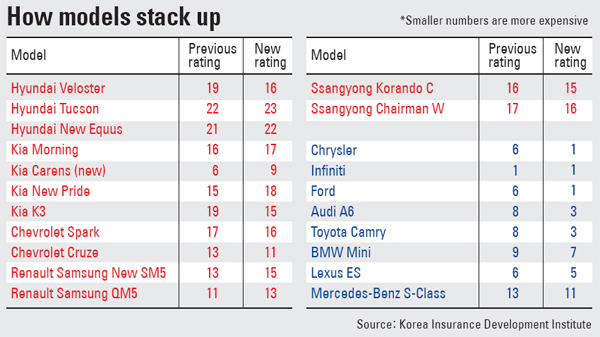Foreign cars hit by insurance rise

The nonprofit organization for the insurance industry on Wednesday announced that the number of ratings for collision coverage, which pays for damage that drivers cause to their own vehicles, will be broadened from 21 to 26 starting next year. In addition, insurance surcharge rates ? the amount insurance payments go up after major accidents ? will increase from 150 percent to 200 percent.
Collision coverage accounts for 24 percent of total auto insurance payouts, according to the KIDI.
These changes to collision payments follow criticism that those who drive imported cars usually have higher repair costs, but pay lower insurance fees, in effect discriminating against people who drive domestic cars and making accidents with foreign cars more expensive.

With the increase in foreign vehicles, insurance claims for foreign makes have also gone up, rising 827 billion won ($779 million) last year, according to KIDI, a 42 percent gain from 2010. Because the large number of insurance claims coming from foreign car accidents has put pressure on insurance companies, there were concerns that insurance fees in general could face a hike.
Instead, the KIDI’s revised plan will create five new high-end ratings categories, which will be applied to 206 models of cars (95 of the 304 models of cars sold in Korea have been excluded because they have not been produced for at least 10 years).
The new ratings are based on a model’s “damageability,“ which accounts for the amount of damage a car model suffers in accidents and how much replacement parts cost, and “repairability,” which assesses whether a car’s parts are easily replaceable and fixable. The current rating system took effect in April 2007 and looks at accident history and damage claims from insurance firms.
The new plan is aimed at raising insurance fees for expensive cars. Unlike the old system, which classified imports by automaker, the new system concentrates on individual brands. In addition, any foreign model that sells more than 10,000 units in Korea will be considered separately.
For example, Lexus will now be evaluated separately from other Toyota makes, and Infiniti separately from other types of Nissans.
In the new rating system, a Toyota Camry will be ranked 3, while the Lexus ES series will be ranked 5.
With the new insurance standard, 66 models will be given higher ratings, meaning the owners will likely pay more insurance fees, while 60 models will be lowered.
Among the 34 foreign models registered in Korea, only two models ? Land Rover and Porsche ? will not face rating hikes.
The KIDI said that the average insurance payment for owners of imported cars could jump 107,000 won annually, about 11.3 percent. However, for owners of Korean cars, the average insurance fee could go down 2.9 percent to 232,000 won.
“Through this system revision, we expect the fairness among insurance holders to be enhanced,” said Kim Sung-ho automobile insurance service director at KIDI.
BY LEE JI-SANG, JOO KYUNG-DON [kjoo@joongang.co.kr]










with the Korea JoongAng Daily
To write comments, please log in to one of the accounts.
Standards Board Policy (0/250자)